The most effective email marketing strategy combines personalization, segmentation, and data-driven optimization. We’ll boost engagement by tailoring content to specific audience segments, using subscribers’ names and behaviors to create relevant messages. Compelling subject lines, mobile-optimized design, and strategic A/B testing are essential for maximizing open rates and conversions. We’ll focus on building a quality list, implementing automation for timely communication, and consistently analyzing metrics to refine our approach. By prioritizing compliance and best practices, we’ll foster trust and authenticity with our audience. This all-encompassing strategy will drive measurable results and keep us ahead in the ever-evolving email marketing landscape. The following insights will equip you with the tools to revolutionize your campaigns.
Understanding Email Marketing Fundamentals
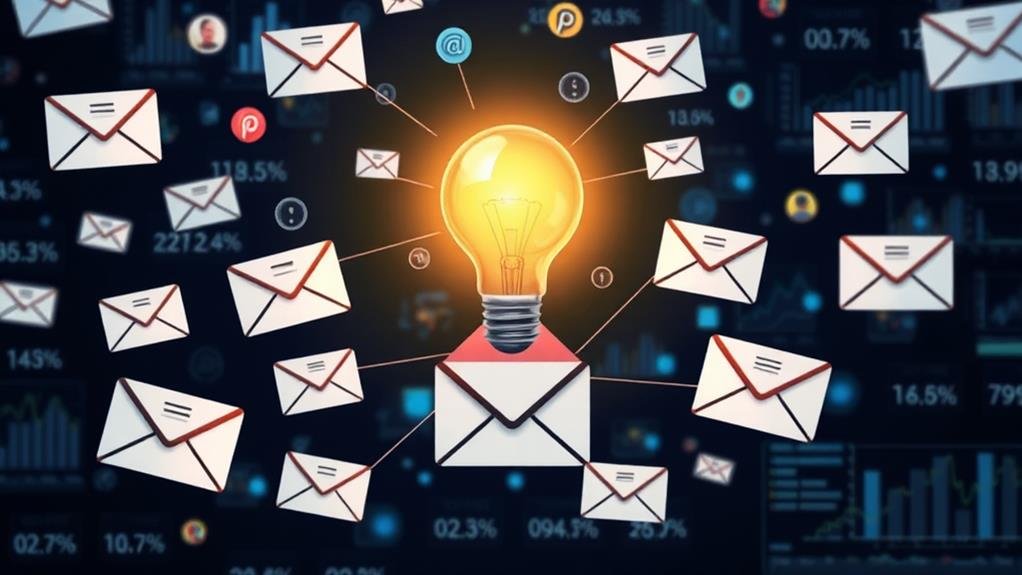
Let’s plunge into the fundamentals of email marketing, a powerful digital strategy that’s becoming increasingly essential for businesses. With over 361 billion emails sent daily and projections reaching 376 billion by 2025, it’s clear that email marketing isn’t just a passing trend.
We’re looking at a robust, cost-effective tool that offers unparalleled ROI – a staggering $42 for every $1 spent. That’s a return you can’t ignore.
But what makes email marketing so effective? It’s all about direct, personalized communication. We’re not just shooting messages into the void; we’re crafting targeted content that speaks directly to our subscribers.
By personalizing subject lines, we can boost open rates by 26%, dramatically increasing our chances of engagement. Furthermore, we’re in control. Unlike other platforms, email marketing gives us the reins, allowing us to reach our audience without external interference.
We can measure our success, tweak our strategies, and continuously improve our campaigns. Essentially, email marketing isn’t just about sending emails; it’s about building relationships, driving sales, and creating a direct line to our customers.
Segmentation for Targeted Campaigns

Now that we’ve grasped the fundamentals of email marketing, we need to focus on a strategy that can considerably boost its effectiveness: segmentation for targeted campaigns.
We can’t ignore the power of this approach, as it’s proven to increase engagement rates by 14% and generate up to 760% more revenue compared to non-segmented campaigns.
Yet, surprisingly, about 70% of brands aren’t utilizing this strategy, leaving a golden opportunity for those who do.
Personalization Techniques

Three key personalization techniques can markedly enhance your email marketing strategy: tailoring subject lines, customizing content, and dynamic product recommendations.
Let’s explore why these matter and how to implement them effectively.
First, personalized subject lines are game-changers. By simply including the recipient’s name or other personalized elements, we can boost open rates by a whopping 26%. It’s a small touch that makes a big difference.
Next, customizing content is essential. When we tailor our message to the individual, we’re not just talking; we’re conversing. This approach can increase transaction rates sixfold compared to generic emails. Even basic personalization, like using the recipient’s name in the greeting, can lift open rates by 10-14%.
But here’s the kicker: segmented campaigns. By delivering content based on subscriber behavior and demographics, we can skyrocket email revenue by 760%.
It’s astounding that 70% of brands aren’t leveraging these techniques. Don’t be part of that statistic. Embrace personalization, and watch your engagement and conversion rates soar.
Compelling Subject Lines
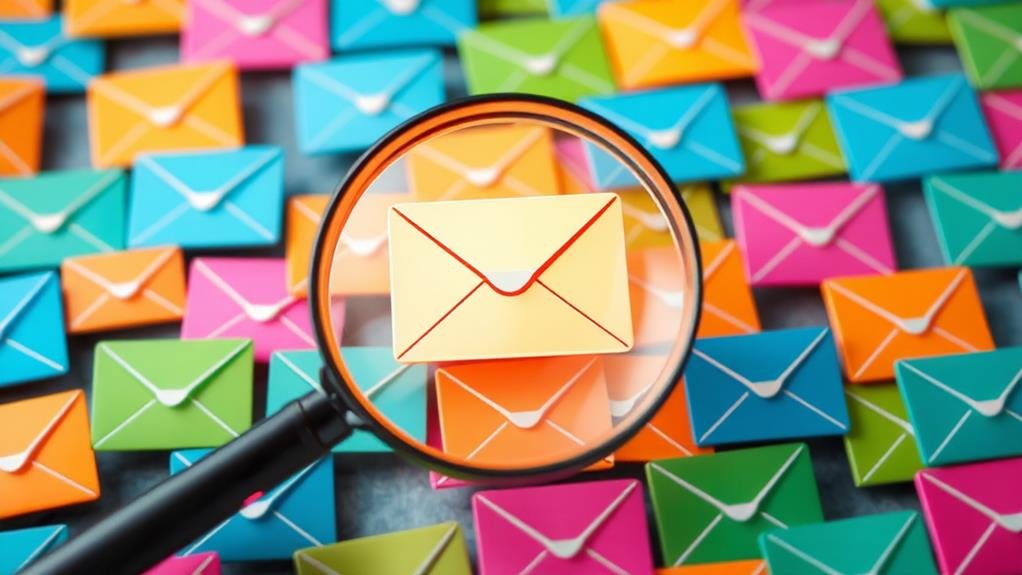
Crafting compelling subject lines is a make-or-break element of email marketing strategy. We can’t overstate their significance: nearly half of recipients decide whether to open an email based solely on the subject line. It’s our first chance to grab attention and entice readers.
Let’s explore what makes a subject line effective. Personalization is key, boosting open rates by a whopping 26%. We’re not just talking about using someone’s name; it’s about tailoring the message to their interests and needs.
Conciseness is essential too. We aim for 6-10 words, striking a balance between informative and digestible. Urgency can be a powerful tool, increasing open rates by up to 22%. But we must tread carefully. Overuse of urgent language can backfire, appearing spammy or manipulative.
Speaking of spam, it’s critical we avoid trigger words that might land us in the junk folder. Remember, 69% of people classify emails as spam based on the subject line alone.
In essence, our subject lines should be personalized, concise, timely, and spam-free. It’s a delicate balance, but one that pays dividends in engagement and conversions.
Mobile-Optimized Email Design

While compelling subject lines get emails opened, mobile-optimized design guarantees they’re read and acted upon. We can’t ignore the fact that 42.3% of users delete emails not optimized for mobile devices. That’s nearly half our potential audience lost before we’ve even made our pitch!
To avoid this pitfall, we must embrace responsive design techniques. These make sure our emails adapt seamlessly to various screen sizes, enhancing user experience and engagement.
But it’s not just about making emails look good on mobile. We need to focus on functionality too. Clear, easily tappable calls to action are vital. Users are far more likely to interact with well-designed buttons than with tiny links.
And let’s not forget the power of testing. By checking our emails across different mobile platforms before sending, we can spot and fix any layout issues that might hinder readability.
The payoff? Mobile-friendly emails yield a 15% higher click-through rate. That’s a significant boost in engagement we can’t afford to ignore.
In today’s mobile-first world, optimizing for smartphones isn’t just smart—it’s essential for email marketing success.
Automation and Drip Campaigns

Automation powerhouse tools have revolutionized email marketing, allowing us to deliver timely, relevant messages without constant manual effort. We’re now able to set up welcome emails, follow-ups, and re-engagement campaigns that reach our subscribers at just the right moment. This efficiency isn’t just convenient; it’s a game-changer for our bottom line.
Let’s talk numbers. Drip campaigns, those clever series of automated emails, are seeing impressive results. Welcome emails boast an average 50% open rate, while click-through rates hover around 30%.
But here’s where it gets really interesting: trigger-based emails, which respond to specific user actions, outperform traditional emails by a whopping 86%. And if you’re not using automated reminders for abandoned carts, you’re leaving money on the table. These timely nudges can recover about 10% of lost sales.
But automation isn’t a set-it-and-forget-it solution. We need to regularly analyze our campaign performance, tweaking and refining our strategies to keep content fresh and aligned with what our subscribers want.
A/B Testing Strategies
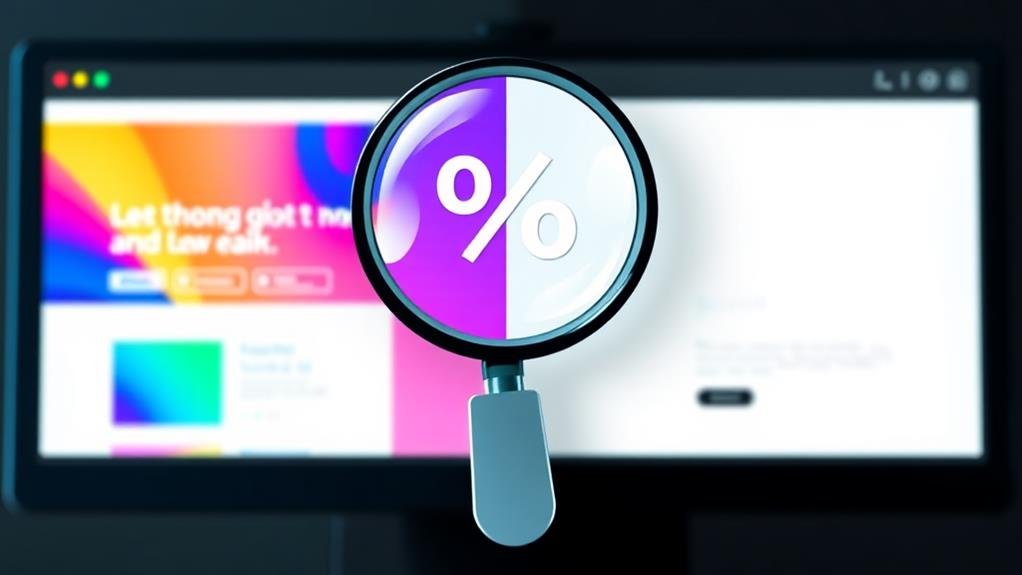
A/B testing is the secret weapon in our email marketing arsenal. It’s our go-to method for experimenting with different email elements, from subject lines to CTAs, allowing us to determine what really resonates with our audience. By testing one variable at a time, we’re able to gain crystal-clear insights into subscriber preferences, which in turn leads to more effective campaigns.
The impact of A/B testing can’t be overstated. We’ve seen open rates skyrocket by up to 49% when we optimize based on testing results. That’s a game-changer for any marketer looking to boost engagement and conversions.
But it’s not just about short-term gains; consistent A/B testing helps us identify long-term trends in subscriber behavior, enabling us to refine our strategies over time.
We can’t stress enough the importance of documenting our A/B testing results. It’s this data-driven approach that guarantees we’re continuously improving and adapting our email marketing strategies.
Metrics and Performance Analysis
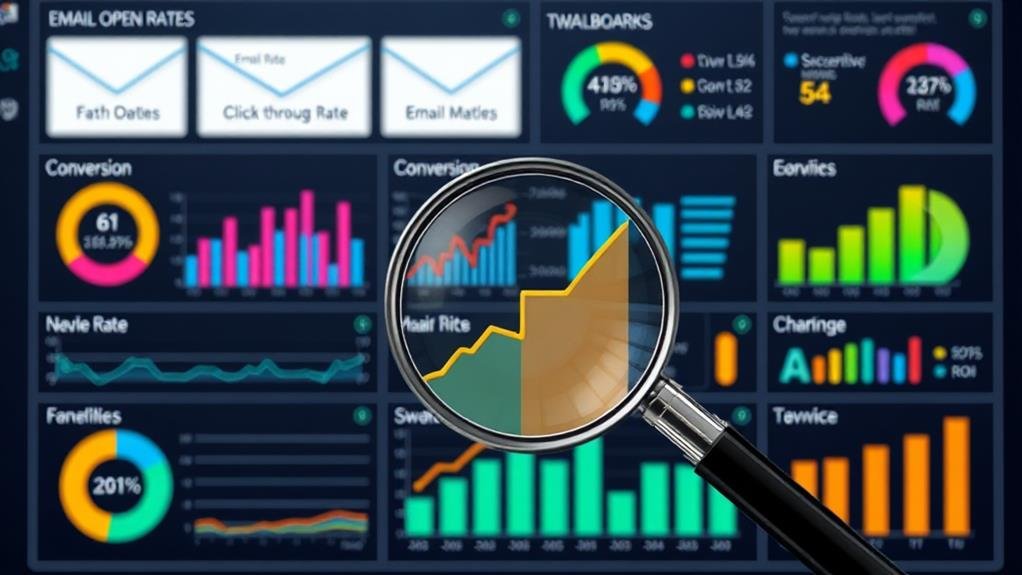
To truly understand the impact of our email marketing efforts, we must dive deep into metrics and performance analysis. It’s not enough to simply send emails and hope for the best; we need to track key performance indicators (KPIs) that reveal the true effectiveness of our campaigns.
Open rates, click-through rates, and conversion rates are the bread and butter of email marketing analytics, providing essential insights into audience engagement and campaign success.
Let’s put things into perspective: the average open rate across industries is 21.33%. How do our campaigns measure up? Are we hitting the mark or falling short? By consistently monitoring these metrics, we can identify trends and make data-driven decisions to improve our strategies.
But don’t stop there – click-through rates, averaging 2.6% across industries, tell us how compelling our content really is. Are we enticing readers to take action?
We can’t forget about unsubscribe rates either. They’re not just numbers; they’re valuable feedback on our content’s relevance and audience satisfaction.
List Building and Management

At the heart of successful email marketing lies a well-managed, high-quality subscriber list. We can’t stress enough the importance of organic growth through value-driven content and strategic incentives.
Don’t be tempted by purchased lists; they’re a surefire way to low engagement and high unsubscribe rates. Instead, let’s focus on smart tactics that work.
First, we need to strategically place sign-up forms on our websites and social media platforms. It’s not just about visibility; it’s about tapping into the 60% of consumers who prefer emails from brands they’ve engaged with.
But here’s the kicker: implementing a double opt-in confirmation isn’t just a good idea—it’s a game-changer. It can slash spam complaints by up to 70% and guarantee we’re reaching people who genuinely want to hear from us.
Now, let’s talk segmentation. By dividing our list based on demographics, purchase history, and engagement levels, we’re not just sending emails—we’re crafting targeted campaigns that could boost revenue by a staggering 760%.
And don’t forget regular list cleaning; it’s the secret sauce that can increase open rates by up to 20%.
Compliance and Best Practices
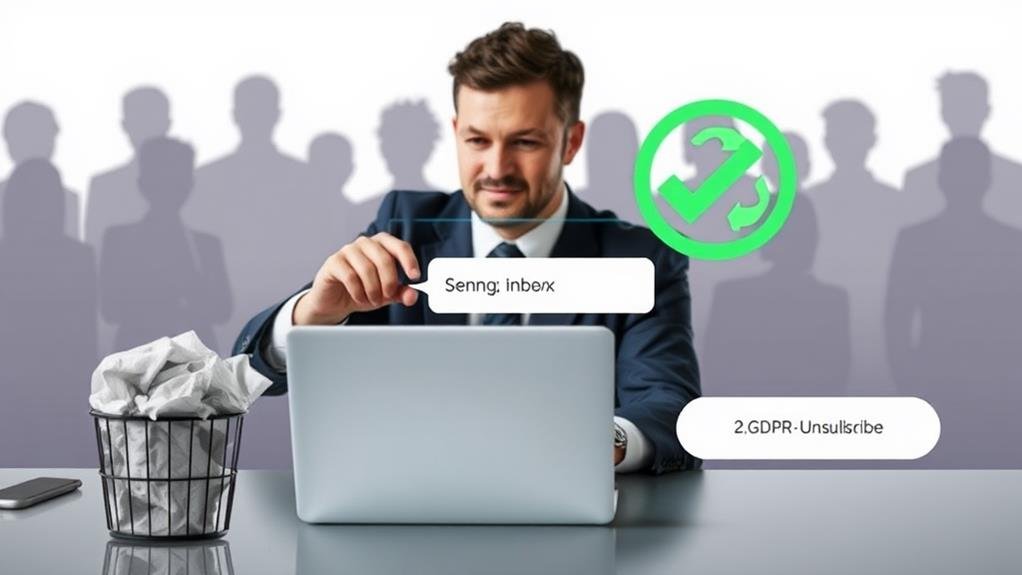
Compliance cornerstones form the foundation of any successful email marketing strategy. We must prioritize obtaining explicit consent from subscribers and maintain transparent data usage policies to avoid hefty penalties.
It’s vital to include a visible, easy-to-use unsubscribe link in every email we send. This not only keeps us in line with regulations but also builds trust with our audience.
We can’t stress enough the importance of authenticity in our communications. Using genuine reply-to addresses and maintaining accurate sender information resonates with consumers, as they prefer brands that communicate in a humanized manner.
Let’s not forget the power of regular list maintenance. By cleaning our email lists, we’re not just improving deliverability; we’re ensuring compliance by removing inactive or unsubscribed contacts.
As we endeavor to create engaging content, we must remember to conduct A/B testing within compliance standards. This approach allows us to refine our messages while staying on the right side of regulations.
Frequently Asked Questions
What Is an Effective Email Marketing Strategy?
We’ve found that an effective email marketing strategy involves audience segmentation, personalization, A/B testing, and automation. Let’s use these tactics to tailor our messages, optimize content, and send timely emails. We’ll also analyze key metrics for continuous improvement.
What Is Best Email Marketing?
We believe the best email marketing combines personalization, A/B testing, and automation. We should focus on mobile optimization, segment our audience, and use compelling subject lines. Let’s monitor KPIs to continually refine our strategies for better results.
What Is the Best Practice for Email Marketing?
We’ve found that the best practices for email marketing include segmenting your audience, personalizing content, maintaining a clean list, A/B testing, and ensuring compliance. These strategies boost engagement, deliverability, and ROI while building trust with subscribers.
How to Win at Email Marketing?
To win at email marketing, we’ll focus on personalization, segmentation, and A/B testing. Let’s automate campaigns, optimize send times, and maintain consistency. We’ll tailor content, use data insights, and always prioritize our audience’s needs for maximum engagement and results.
In Closing
We’ve explored a range of effective email marketing strategies, from segmentation to A/B testing. Remember, there’s no one-size-fits-all approach. The most successful campaigns combine these tactics, tailoring them to your audience and goals. By continuously analyzing metrics, refining your approach, and staying compliant with best practices, you’ll create emails that resonate and convert. It’s an ongoing process of learning and improvement. Keep experimenting, stay adaptable, and you’ll reveal the full potential of email marketing for your business.
